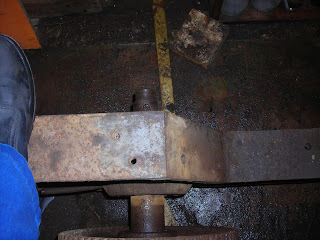Here it is again:
First, note A and B. A is a cable running into the battery box, repeated at the other end. No clue as to what for (other than "to carry electricity"), but handy to know it was there.
B is some sort of data plate-maybe the works plate, maybe battery data, could be anything cos I can't read it! Hopefully a better copy of the original would show it up, if I ever find it.
C and D are more useful now though. Note how in oval D, the back of the bufferbeam and part of the frames is just distinguishable in the shadow. It seems to be a lighter colour than the black middle section, which isn't in shadow.
C shows how the buffer beam looks a lighter colour, but with the edges in a darker shade. For reference, here is it built up:
Obviously a junior SGLR member was used to recreate (ish) the other photo!
At first glance, BEV seems to be pure rust, but there are still flecks of paint. Even better,
removing the wheels has exposed areas that are inaccessible to someone giving it a quick tart up, and protected by grease. A quick clean up revealed...
The red in the top right isn't actually the colour I'm looking for. Initially I thought this was it, hence BEV was painted red when I did the top half. I now think it is actually red oxide primer, presumably the result of a quick tart up by a previous owner.
Instead, look at the vague arc going bottom right to top left. That is where the wheel was, and where the mystery painter couldn't reach. The black is old grease, and in the middle...the original Grey! The darker flecks are bare metal.
Further investigation found this grey patch on top of the frame:
So thats the lighter colour probably settled. For me, the patch behind the wheels seals it. Theres no more paint behind or on top of it, I doubt industrial owners would take off wheels for a repaint-if they ever painted it-and I reckon if anyone in preservation took a wheel off to paint behind, it'd either have had a more obvious start made or been left in a million bits until scrapped.
The buffer beam edge that shows dark in the photo threw up this:
Again, red is most likely red oxide.The black in the middle seems to be paint, the small flecks of grey beneath are bare metal. At least, the black flicks off with a knife blade leaving the grey flecks behind.
Finally, the wheels:
In the scraped away patch: Silver seems to be a tart up, with thick layer(s) of black beneath, then grey, then red oxide. Why they originally put primer on the wheels yet none apparently on the frames is a mystery, maybe they couldn't be bothered?
So, it looks like light grey (probably battleship grey) and black may be the colours shown in the old photo. Ironically, I've often said we should paint it grey and black because the picture is in grey and black! Besides, it should look very smart like that.




















